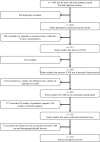Who Uses CAM? A Narrative Review of Demographic Characteristics and Health Factors Associated with CAM Use
- PMID: 18955327
- PMCID: PMC2816378
- DOI: 10.1093/ecam/nen023
Who Uses CAM? A Narrative Review of Demographic Characteristics and Health Factors Associated with CAM Use
Abstract
Complementary and Alternative Medicines (CAM) are used by an extensive number of patients in the UK and elsewhere. In order to understand this pattern of behavior, it is helpful to examine the characteristics of people who use CAM. This narrative review collates and evaluates the evidence concerning the demographic characteristics and health status factors associated with CAM use in community-based non-clinical populations. A systematic literature search of computerized databases was conducted, and published research papers which present evidence concerning associations between CAM use and demographic and health characteristics are discussed and evaluated. The evidence suggests that people who use CAM tend to be female, of middle age and have more education. In terms of their health, CAM users tend to have more than one medical condition, but might not be more likely than non-users to have specific conditions such as cancer or to rate their own general health as poor. The multivariate studies that have been conducted suggest that both demographic and health characteristics contribute independently to CAM use. In conclusion, demographic characteristics and factors related to an individual's health status are associated with CAM use. Future research is needed to address methodological limitations in existing studies.
Keywords: CAM use; patient characteristics; review.
Figures
Similar articles
-
The effectiveness of health literacy interventions on the informed consent process of health care users: a systematic review protocol.JBI Database System Rev Implement Rep. 2015 Oct;13(10):82-94. doi: 10.11124/jbisrir-2015-2304. JBI Database System Rev Implement Rep. 2015. PMID: 26571285
-
The future of Cochrane Neonatal.Early Hum Dev. 2020 Nov;150:105191. doi: 10.1016/j.earlhumdev.2020.105191. Epub 2020 Sep 12. Early Hum Dev. 2020. PMID: 33036834
-
The experiences of persons living with HIV who participate in mind-body and energy therapies: a systematic review protocol of qualitative evidence.JBI Database System Rev Implement Rep. 2015 Oct;13(10):41-9. doi: 10.11124/jbisrir-2015-2321. JBI Database System Rev Implement Rep. 2015. PMID: 26571281
-
An integrative review of complementary and alternative medicine use for back pain: a focus on prevalence, reasons for use, influential factors, self-perceived effectiveness, and communication.Spine J. 2015 Aug 1;15(8):1870-83. doi: 10.1016/j.spinee.2015.04.049. Epub 2015 May 9. Spine J. 2015. PMID: 25962340 Review.
-
A systematic review of the traits and cognitions associated with use of and belief in complementary and alternative medicine (CAM).Psychol Health Med. 2018 Aug;23(7):854-869. doi: 10.1080/13548506.2018.1442010. Epub 2018 Feb 22. Psychol Health Med. 2018. PMID: 29468890
Cited by
-
A sociobehavioral wellness model of acupuncture use in the United States, 2007.J Altern Complement Med. 2014 Jan;20(1):32-9. doi: 10.1089/acm.2012.0120. Epub 2013 Feb 15. J Altern Complement Med. 2014. PMID: 23414108 Free PMC article.
-
Patient Journeys of Nonintegration in Hungary: A Qualitative Study of Possible Reasons for Considering Medical Modalities as Mutually Exclusive.Integr Cancer Ther. 2018 Dec;17(4):1270-1284. doi: 10.1177/1534735418801533. Epub 2018 Sep 26. Integr Cancer Ther. 2018. PMID: 30256678 Free PMC article.
-
Use of Mind-Body Therapies Among Young Adults Aged 18-24 Years: Findings From the 2012 National Health Interview Survey.J Adolesc Health. 2018 Aug;63(2):227-232. doi: 10.1016/j.jadohealth.2018.03.014. Epub 2018 Jul 1. J Adolesc Health. 2018. PMID: 29970333 Free PMC article.
-
Wellness or medicine? Use and perception of Ayurveda in Germany: data from an online-representative cross-sectional study.Front Med (Lausanne). 2024 May 22;11:1408609. doi: 10.3389/fmed.2024.1408609. eCollection 2024. Front Med (Lausanne). 2024. PMID: 38841569 Free PMC article.
-
Kidney dysfunction and cerebral microbleeds in neurologically healthy adults.PLoS One. 2017 Feb 16;12(2):e0172210. doi: 10.1371/journal.pone.0172210. eCollection 2017. PLoS One. 2017. PMID: 28207801 Free PMC article.
References
-
- Thomas KJ, Nicholl JP, Coleman P. Use and expenditure on complementary medicine in England: a population based survey. Complement Ther Med. 2001;9:2–11. - PubMed
-
- Chang HY, Wallis M, Tiralongo E. Use of complementary and alternative medicine among people living with diabetes: literature review. J Adv Nurs. 2007;58:307–19. - PubMed
-
- Slader CA, Reddel HK, Jenkins CR, Armour CL, Bosnic-Anticevich SZ. Complementary and alternative medicine use in asthma: Who is using what? Respirology. 2006;11:373–87. - PubMed
-
- Wootton JC, Sparber A. Surveys of complementary and alternative medicine: part I. General trends and demographic groups. J Altern Complement Med. 2001;7:195–208. - PubMed
-
- Adams J, Sibbritt D, Easthope G, Young AF. The profile of women who consult alternative health practitioners in Australia. Med J Aust. 2003;179:297–300. - PubMed
LinkOut - more resources
Full Text Sources


